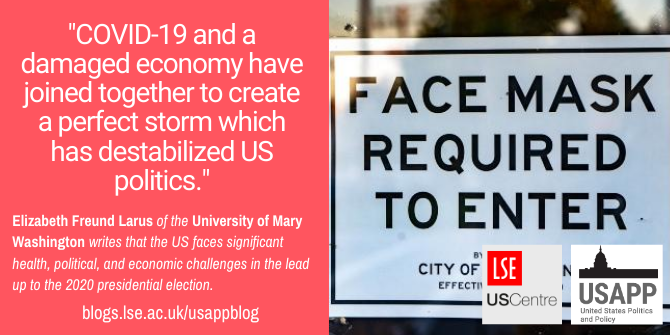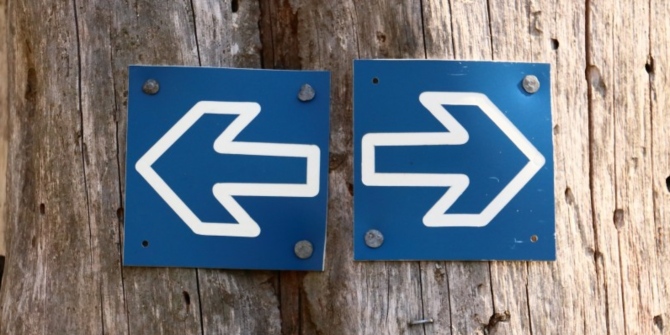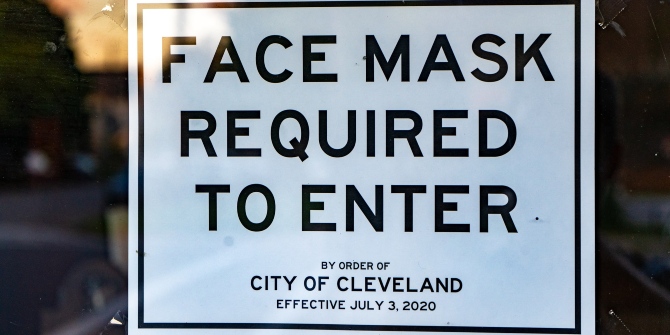 Millions of coronavirus infections and thousands of COVID-19 related deaths and an economic recession threaten US political stability. Elizabeth Freund Larus assesses the impact of the COVID-19 crisis, economic difficulties and the uncertainty of the 2020 elections on US political stability.
Millions of coronavirus infections and thousands of COVID-19 related deaths and an economic recession threaten US political stability. Elizabeth Freund Larus assesses the impact of the COVID-19 crisis, economic difficulties and the uncertainty of the 2020 elections on US political stability.
With more than 5 million confirmed infections and over 166,000 deaths, the United States leads the world in COVID-19 casualties. While several states that had resisted shutting down businesses and social gathering sites are now issuing stay-at-home orders, others that had reopened after months of shutdown are retrenching. Amid this turmoil, US President Donald Trump has tried to restart his 2020 presidential campaign. We should expect resistance to the Trump White House and efforts to overturn the existing social order to deepen in the coming months.
The huge effects of the COVID-19 pandemic
COVID-19 has dealt a heavy blow to US residents. Much of the country has been under some sort of lockdown since late March. With warmer weather and the rate of infections slowing in some states, some governors called for relaxing stay-at-home orders. Surges in coronavirus cases in late June and mid-July forced several governors and mayors to impose new restrictions on residents, to reimpose stay-at-home orders, or backtrack on reopening their states or cities.
The surges and accompanying retrenchment are damaging to the American psyche and the US economy. Hundreds of millions of Americans obeyed their leaders’ orders and stayed home, but at the same time, have lost substantial income, their jobs, and for many, loved ones. While Trumps’ supporters largely give him good grades for closing the country’s borders and letting governors and mayors call the shots in their jurisdictions, his critics claim that Trump’s response was slow and muddled. His supporters praised his efforts to try existing remedies, such as hydroxychloroquine, which the president himself is taking. His detractors claimed that the drug was dangerous. The US media, which is nearly universally critical of Trump, portray the president as incompetent.
In April, lockdown protests spread from Michigan to Missouri to Maine and then throughout the country as unemployment soared. Director of the National Institute of Allergy and Infectious Diseases, Anthony Fauci in early April had warned states that it was time to stop allowing any exemptions to social-distancing guidelines. Fearful for their livelihoods, thousands of Americans protested what they believed to be excessive lockdown measures in some states, such as Michigan where Governor Gretchen Whitmer imposed some of the strictest measures in the nation. Some Americans became disillusioned with the lockdown measures when it became evident that the high rate of COVID cases in New York, the state that had the most cases, was linked to placing infected people in nursing homes, thereby infecting a vulnerable population.
Challenges now and ahead for the US economy
The new coronavirus has caused significant damage to the US economy. Forced lockdowns shuttered businesses, some permanently, and caused unemployment from an historic low of 3.5 percent in December 2019 to nearly 15 percent in April, with some 23 million Americans out of work. Unemployment claims reached historic levels. In response, Congress passed the $2 trillion CARES Act to provide relief to individuals, corporations, small businesses, state and local government, public health, and education. Separate bills have provided $19 billion in relief for agriculture and a $25 billion bailout for airlines. To stimulate the economy, the Federal Reserve cut interest rates to near zero and began purchasing sizable quantities of Treasury securities and agency mortgage-backed securities, among other moves.
After enduring months of forced shut-downs, businesses began to reopen in May, albeit with strict limitations. Consumer spending in May was up more than 8 percent, higher than anticipated, with the stock market nearly back to pre-pandemic levels. Many businesses remain shuttered, however, and others closed for good. Signs of a second wave in June caused markets to waver and some businesses to reclose. A second wave would likely permanently shutter many businesses that had barely survived the first wave. The first wave hurt laborers and service workers the most because they could not work from home. The second wave will also hurt higher paid workers employed in professional services, such as finance, real estate, and higher education as demand for those services begin to dry up. Their contribution to the US economy will dry up with their paychecks, further compounding the country’s economic woes.

Photo by DJ Johnson on Unsplash
US Federal Reserve Chairman Jerome Powell in his June 16, 2020 comments to Congress indicated that economic recovery would be slow and incomplete for many years. Key determinants to economic recovery are the path of COVID-19 and efforts to contain it. A bright spot on the horizon are unemployment numbers, which have been falling as businesses reopen. The numbers of people applying for unemployment has steadily decreased for the past 15 months, from a peak of nearly 7 million in March to 1.37 in July. Non-farm employment increased by nearly 5 million in June, following an increase of 2.7 million in May.
2020 election uncertainty
Trump’s chances for reelection are uncertain. His job approval rating was evenly split between approval and disapproval (44 percent) at the beginning of his presidency. The gap widened to in December 2017 to 38 percent approve and 58 percent disapprove, but closed to near parity in March 2020 (47 percent disapprove and 50 percent approve) as the US unemployment rate reached 3.5 percent, the lowest in 40 years, and the economy added 273,000 jobs in February alone. By late June, however, President Trump’s approval rating had dropped back to 41 percent; 55 percent of Americans disapproved of his performance as president. Surprisingly, however, Trump’s approval rating is currently higher than the 37 percent that is was before the 2016 presidential election. (Hillary Clinton’s approval rating was 42 percent.) The drop in Trump’s approval rating stems from criticism of his handling of the COVID-19 outbreak in the United States, his crude insults of his adversaries, and the state of the US economy. To compound his political troubles, more Americans are dissatisfied than satisfied with the direction that the country moving. In June 2020, only 25 percent of Americans polled agreed that the US is moving in the right direction, down from nearly 50 percent in February, before the virus hit. In June, 68 percent of respondents indicated that the country is on the wrong track, up from around 50 percent in February.
The fact that Trump’s approval ratings are not lower despite the country’s economic and social woes indicate that the Trump’s base still supports him. Trump tried to jump start his reelection campaign in late June by holding a campaign rally in Oklahoma. Turnout was disappointing for various reasons, including fears over a spike in virus infections in the state, concerns over social-distancing, protestors blocking entrances, and allegedly thousands of no-shows who had reserved tickets but failed to show up as a protest against Trump. Despite the support from his loyal base, votes from independents and voter turnout will determine who will be the next US president.
COVID-19 and the summer protests are likely to affect the 2020 elections. The Democratic Party currently holds a majority of seats in the US House of Representatives, which means that the party has more seats to defend. In the Republican-held the Senate, the Republican Party needs to defend more seats than the Democrats. The pandemic has suspended traditional campaign strategies, and incumbency is generally an advantage. Elections with incumbent presidents are commonly status quo elections, in which the parties maintain their numbers in Congress. The game changer this year is the blow that the US economy suffered due to COVID-19. Polls indicate that voters are most concerned with the economy (25 percent), health care (23 percent), the coronavirus in America (17 percent) and foreign affairs (10 percent).
President Trump and the Senate Republicans will have difficulty being reelected if the economy does not improve. While President Trump and Republicans have every incentive to reopen the US economy, the Democrats have every incentive to keep it closed. Reopening the economy risks unleashing a second wave of the pandemic, a risk the Republicans are trying to downplay. President Trump needs 270 electoral college votes to win reelection. He can reach this threshold only if he wins all the states that he won in 2016 (for a total of 260 Electoral College votes) and at least one of the swing states of Pennsylvania, Michigan, and Wisconsin that he won in 2016. The state of the US economy and the pandemic will determine the outcome of the elections in these swing states.
A perfect storm in an election year
COVID-19 and a damaged economy have joined together to create a perfect storm which has destabilized US politics. Expect political rhetoric to become more heated as the presidential campaigns get into full swing later this summer, further polarizing American society.
Please read our comments policy before commenting.
Note: This article gives the views of the author, and not the position of USAPP – American Politics and Policy, nor the London School of Economics.
Shortened URL for this post: https://bit.ly/3h8Skrs
About the author
 Elizabeth Freund Larus – University of Mary Washington
Elizabeth Freund Larus – University of Mary Washington
Elizabeth Freund Larus is Chairman of the Department of Political Science and International Affairs at the University of Mary Washington in Virginia, USA.





